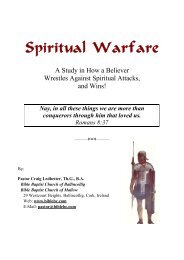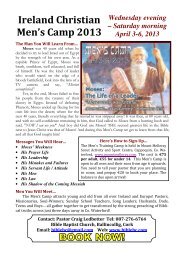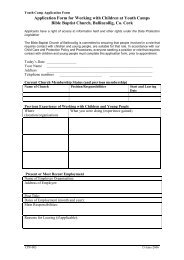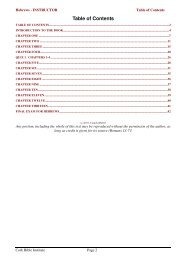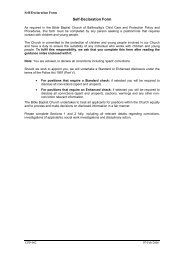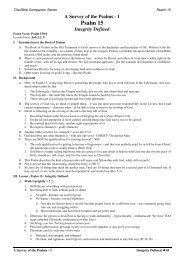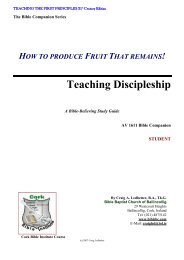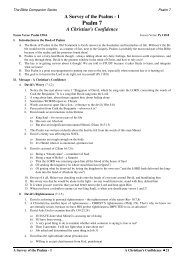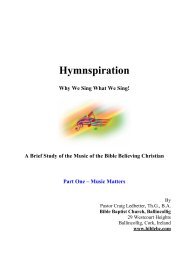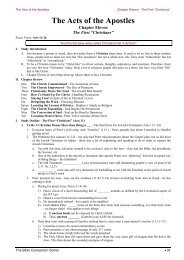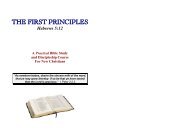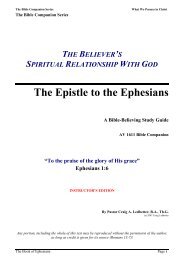Old Testament Survey - Student.pdf - Bible Baptist Church of Blarney
Old Testament Survey - Student.pdf - Bible Baptist Church of Blarney
Old Testament Survey - Student.pdf - Bible Baptist Church of Blarney
You also want an ePaper? Increase the reach of your titles
YUMPU automatically turns print PDFs into web optimized ePapers that Google loves.
<strong>Old</strong> <strong>Testament</strong> <strong>Survey</strong> – <strong>Student</strong> Edition<br />
1&2 Chronicles, Ezra, Nehemiah<br />
Ezra<br />
Author: Tradition has it that the Prophet __________ wrote the Book <strong>of</strong> Ezra. It is interesting to note<br />
that once Ezra appears on the scene in Ezra chapter 7, the author <strong>of</strong> the Book <strong>of</strong> Ezra switches from<br />
writing in the third person, to first person.<br />
Date <strong>of</strong> Writing: The Book <strong>of</strong> Ezra was likely written between 460 and 440 B.C.<br />
Purpose <strong>of</strong> Writing: The Book <strong>of</strong> Ezra is devoted to events occurring in the land <strong>of</strong> Israel at the time<br />
<strong>of</strong> the return from captivity and subsequent years, covering a period <strong>of</strong> approximately 100 years,<br />
beginning in 538 B.C. The emphasis in Ezra is on the rebuilding <strong>of</strong> the Temple. The book contains<br />
extensive genealogical records, principally for the purpose <strong>of</strong> establishing the claims to the priesthood<br />
on the part <strong>of</strong> the descendants <strong>of</strong> Aaron. These were needed to know who was supposed to be the<br />
High Priest.<br />
Key Verses: The rejoicing for the rebuilding <strong>of</strong> the Temple (Ezra 3:11); Just how great was this man<br />
Ezra (Ezra 7:6)<br />
Brief Summary: The book may be divided as follows: I. The First Return under Zerubbabel, and the<br />
Building <strong>of</strong> the Second Temple (Ezra chapters 1 – 6), and II. The Ministry <strong>of</strong> Ezra (Ezra chapters 7 –<br />
10). Since well over half a century elapsed between chapters 6 and 7, the characters <strong>of</strong> the first part <strong>of</strong><br />
the book had died by the time Ezra began his ministry in Jerusalem. Ezra is the one person who is<br />
prominent in both the books <strong>of</strong> Ezra and Nehemiah. Both books end with prayers <strong>of</strong> confession for sin<br />
(Ezra 9; Nehemiah 9) and a subsequent separation <strong>of</strong> the people from the sinful practices into which<br />
they had fallen. Some <strong>of</strong> the encouraging messages <strong>of</strong> Haggai and Zechariah, who are introduced in<br />
this narrative (Ezra 5:1), may be seen in the prophetic books that bear their names. The Book <strong>of</strong> Ezra<br />
covers the return from captivity to rebuild the Temple up to the decree <strong>of</strong> Artaxerxes (445 BC), the<br />
event covered at the beginning <strong>of</strong> the Book <strong>of</strong> Nehemiah. ________ was the main prophet in the day<br />
<strong>of</strong> Ezra, and _____________ was the prophet in the day <strong>of</strong> Nehemiah.<br />
Practical Application: Because <strong>of</strong> Ezra, Israel made it back to worshipping God in the Temple. God<br />
didn’t leave Ezra to do this single-handedly; he gave him substantial and special help in the person <strong>of</strong><br />
Nehemiah, whose work providentially converged with his. The idea <strong>of</strong> the Jews being the “People-<strong>of</strong>-<br />
God” was recovered and preserved through the efforts <strong>of</strong> Ezra and Nehemiah. Ezra used Worship and<br />
<strong>Bible</strong> to do it. Ezra engaged the people in the worship <strong>of</strong> God, the most all-absorbing, comprehensive<br />
act in which men and woman can engage. This is how our God-formed identities become most deeply<br />
embedded in us. And Ezra led them into an obedient listening to the words <strong>of</strong> Scripture. Listening and<br />
following God’s revelation are the primary ways in which we keep attentively obedient to the living<br />
presence <strong>of</strong> God among us.<br />
A Simple Outline <strong>of</strong> the Book <strong>of</strong> Ezra<br />
I. The Decree <strong>of</strong> Cyrus the Persian (1:1-4)<br />
II. Return <strong>of</strong> the Exiles Led by Sheshbazzar to Jerusalem (1:5-11)<br />
III. Return <strong>of</strong> Exiles Led by Zerubbabel and Jeshua to Jerusalem (2:1-6:22)<br />
A. List <strong>of</strong> those who returned (2:1-67)<br />
B. Temple building fund (2:68-69)<br />
C. Living arrangements (2:70)<br />
D. Rebuilding <strong>of</strong> Temple (3:1-6:18)<br />
1. Initial preparations (3:1-9)<br />
2. Laying the foundation (3:10-13)<br />
3. Opposition halts the rebuilding (4:1-24)<br />
4. Haggai, Zechariah, Zerubbabel, and Jeshua encourage people (5:1-2)<br />
5. Darius allows rebuilding to continue (5:3-6:13)<br />
6. Work proceeds well (6:14)<br />
CBI - Practical Doctrine Page 57



